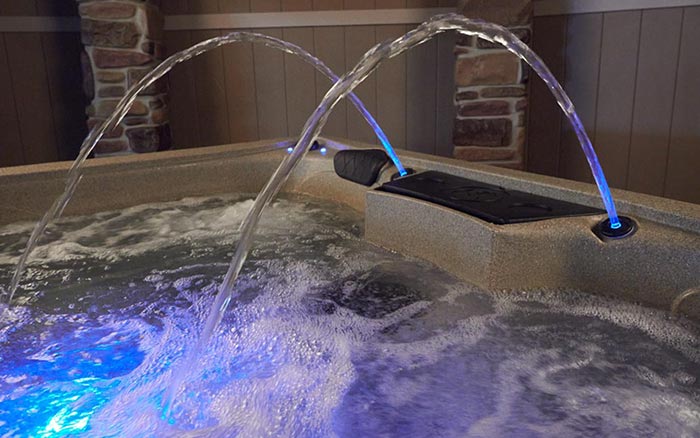For some people, one of the most intimidating parts of spa ownership is learning the chemical maintenance. There’s definitely a learning curve for figuring out just what chemicals are needed for what. But don’t be nervous; we’ve got you covered. Here’s our comprehensive guide to hot tub chemicals.
Maintain Balance
First, a word on balance. There are a few things you can do to help keep your hot tub chemicals balanced. But, when it comes to hot tub chemical maintenance, your best bet is always going to be to maintain the status quo. It’s almost always easier to maintain the chemical balance in your hot tub than it is to overcome any larger imbalance by adding extra chemicals, so it’s good to start with this goal in mind. You’ll want to manage your expectations. Your routine should be to check your spa chemicals at least once a week, although two to three times a week will probably lead you to more success.
If you make checking your chemicals part of your routine, then you’re more likely to remember. There are also added benefits to keeping those chemicals in check, like longevity of your systems and a more efficient use of your chemicals. Basically, one of the best things you can do for the maintenance of your hot tub is to regularly check those chemicals and add more as needed. But how do you know what’s going on with your chemicals? We’re glad you asked.
pH
The measure of how basic or alkaline your water is is known as pH (potential Hydrogen, if you’re really curious). pH is one of the most important factors in determining how comfortable the water is for your body. Anything above the level 7 is considered basic and anything below is considered acidic. Water typically sits right around 7 on the scale, and the human body has a pH of around 7.4.
An imbalance in pH can cause your mucous membranes to become red and irritated. We’re talking about red eyes and itchy skin. And that’s just not the relaxing hot tub experience you were promised, now is it? It’s also important to note that an imbalance in pH can cause your chlorine to be less effective at sanitizing your spa. pH imbalances can also cause your hot tub’s working parts to deteriorate more quickly. We say all of this to emphasize the importance of pH levels in your hot tub. So what can you do about it?
Luckily for pH and you, the chemicals you’ll need to adjust your pH levels are aptly named pH increaser and pH decreaser. So, for the most part, if the levels are too high, you add decreaser. And if they’re too low, you add increaser. But, there’s another level that closely impacts pH. One that you should definitely take into consideration when you’re working with your hot tub chemicals.
Alkalinity
That other level is alkalinity. Alkalinity makes it easier to maintain pH levels in your spa. It keeps your pH levels from changing rapidly by affecting how your water reacts to some of the natural inputs like rain or dust.
If your total alkalinity is too low, your pH levels can more easily change from low to high or vice versa. This can cause your water to turn green in the short term. In the long term, it can begin to affect the surfaces in your spa and your equipment. If your total alkalinity is too high, the pH levels can also be affected. High total alkalinity can lead to cloudy water and build-up. No one likes cloudy water, and no one needs excess build up in their hot tub or on their equipment.
Bottom line for total alkalinity? Balance. Shocker—we know. Speaking of shock, that leads us to our next two chemical contenders in our guide, sanitizers and shock.
Sanitzer
Your hot tub sanitizer is dependent on the kind of system you have for the type of spa or hot tub you have. The most well-known sanitizers for hot tubs are chlorine and bromine. And both sanitizers do just that, sanitize your water. The chemical sanitizers you use will depend largely on the particular hot tub you have. For example, the HotSpring® Highlife® and Limelight® spa lines use the FreshWater® Salt System which uses salt to produce chlorine. While the Freeflow® spa lines utilize the SpaGuard® bromine kit.
Whatever system your hot tub needs, your sanitizer is the chemical that will be doing the actual killing of bacteria. In terms of how much to add and when, that depends on your system. Some systems require a weekly dose of sanitizer, while others have automatic cartridges that add sanitizer as it’s needed. Either way, you’ll begin to know what your spa needs and when as you start the process of learning to care for and maintain your hot tub’s chemicals. And when your sanitizer needs a little boost, that’s where shock comes in.
Shock
In the line up of our guide to hot tub chemicals, we’ve finally come to shock. Shock is the chemical that you use after your hot tub has seen a lot of traffic or when you begin to smell that familiar chlorine smell. Shock gives your sanitizer a boost and helps to get rid of any extra bacteria or contaminants that might be enjoying themselves a little too much in your spa. It helps by breaking down the buildup of bacteria and other contaminants that have been neutralized by the sanitizer.
The recommended usage for shock is once a week, and then again after there have been a larger than normal amount of people in your hot tub.
Ask for Help
When it’s all said and done, learning to maintain your hot tub is a lot like riding your bike. Just get started and keep trying. You’ll get the hang of it. Like always, our experts at Texas Hot Tub Company are more than happy to help you figure out the next step. Be sure to keep this guide to hot tub chemicals handy, and remember the goal is balance.


